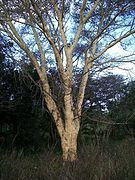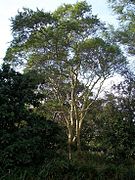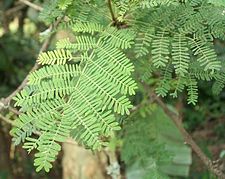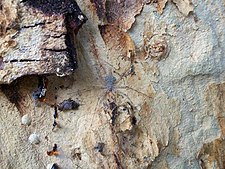Vachellia xanthophloea
| Fever tree | |
|---|---|
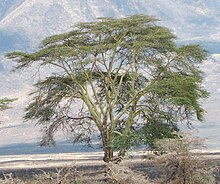
| |
| Scientific classification | |
| Kingdom: | |
| (unranked): | |
| (unranked): | |
| (unranked): | |
| Order: | |
| Family: | |
| Genus: | |
| Species: | V. xanthophloea
|
| Binomial name | |
| Vachellia xanthophloea (Benth.) P.J.H.Hurter[1]
| |
| Synonyms | |
|
Acacia xanthophloea Benth. | |

Vachellia xanthophloea is a tree in the Fabaceae family and is commonly known in English as the fever tree (local East African names include olerai, kimwea, murera, and mwelele). This species of Vachellia is native to eastern and southern Africa. It can be found in Botswana, Kenya, Malawi, Mozambique, Somalia, South Africa, Swaziland, Tanzania, Zambia and Zimbabwe. It has also become a landscape tree in other warm climates, outside of its natural range.
Description
The trees grow to a height of 15–25 m. The characteristic bark is smooth, powdery and greenish-yellow in colour. It is one of the few trees where photosynthesis takes place in the bark. Straight, white spines grow from the branch nodes in pairs. The leaves are twice compound, with small leaflets (8×2 mm). The flowers are produced in scented pale cream spherical inflorescences, clustered at the nodes and towards the ends of the branches.
Fever trees are fast-growing and short-lived. They have a tendency to occur as single-aged stands, and are subject to stand-level diebacks that have been variously attributed to elephants, water tables, and synchronous senescence.[2][3][4][5]
Etymology
The name xanthophloea is derived from Greek and means "yellow bark" (ξανθός "yellow, golden"; φλοιός "bark"). The common name, fever tree, comes from its tendency to grow in swampy areas: early European settlers in the region noted that malarial fever was contracted in areas with these trees. It is now understood that malarial fever is spread by mosquitos living in the swampy areas that often support this tree species, and not by the tree species itself. [6]
Associated species
It is a host for the root parasite Sarcophyte sanguinea.
In popular culture
These trees are immortalized by Rudyard Kipling in one of his Just So Stories, The Elephant's Child, wherein he repeatedly refers to "the great grey-green, greasy Limpopo River, all set about with fever-trees."[7]
Gallery
-
A Fever tree planted outside of its natural range at Ilanda Wilds
-
Planted at Umdoni Bird Sanctuary
-
Foliage and branches
-
Leaves
-
Branches
-
A spider on the stem
Notes and references
- ^ Kyalangalilwa B, Boatwright JS, Daru BH, Maurin O, van der Bank M. (2013). "Phylogenetic position and revised classification of Acacia s.l. (Fabaceae: Mimosoideae) in Africa, including new combinations in Vachellia and Senegalia". Bot J Linn Soc. 172 (4): 500–523. doi:10.1111/boj.12047.
{{cite journal}}: CS1 maint: multiple names: authors list (link) - ^ Western, D. & C. Van Praet (1973). "Cyclical changes in the habitat and climate of an East African ecosystem". Nature. 241 (5385): 104–106. doi:10.1038/241104a0.
- ^ Young, T.P. and W.K. Lindsay (1988). "Role of even-aged population structure in the disappearance of Acacia xanthophloea woodlands". African Journal of Ecology. 26: 69–72. doi:10.1111/j.1365-2028.1988.tb01130.x.
- ^ Ruess, R.W. and F.L. Walter (1990). "The impact of large herbivores on the Seronera woodlands, Serengeti National Park, Tanzania". African Journal of Ecology. 28 (4): 259–275. doi:10.1111/j.1365-2028.1990.tb01161.x.
- ^ Mills, A.J. (2006). "The role of salinity and sodicity in the dieback of Acacia xanthophloea in Ngorongoro Caldera, Tanzania". African Journal of Ecology. 44: 61–71. doi:10.1111/j.1365-2028.2006.00616.x.
- ^ Vachellia xanthophloea (as Acacia xanthophloea) entry at PlantZAfrica.com
- ^ "The Elephant's Child
Bibliography
- Pooley, E. (1993). The Complete Field Guide to Trees of Natal, Zululand and Transkei. ISBN 0-620-17697-0.
External links
- Dressler, S.; Schmidt, M. & Zizka, G. (2014). "Acacia xanthophloea". African plants – a Photo Guide. Frankfurt/Main: Forschungsinstitut Senckenberg.

